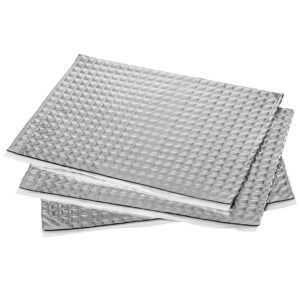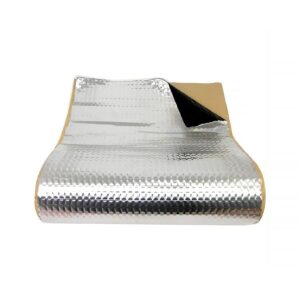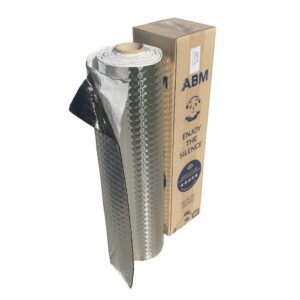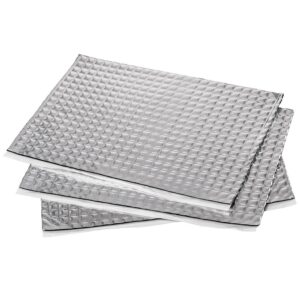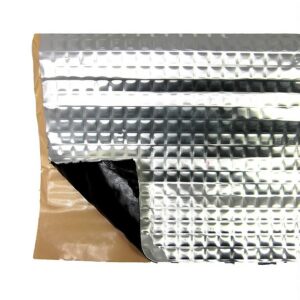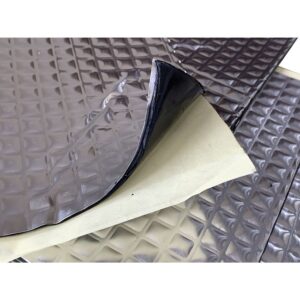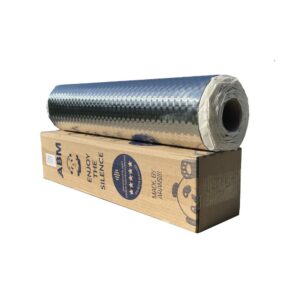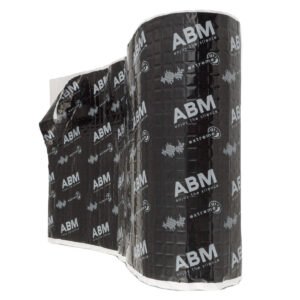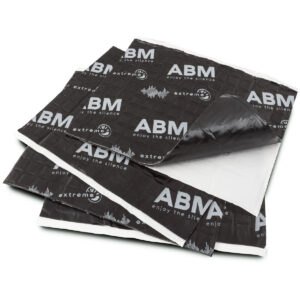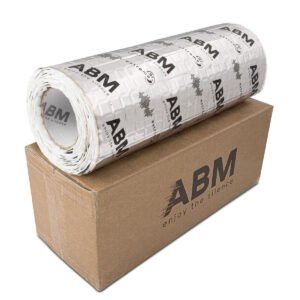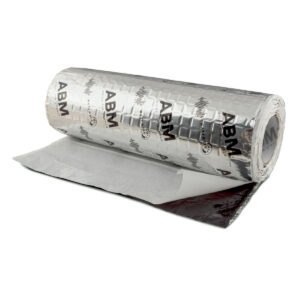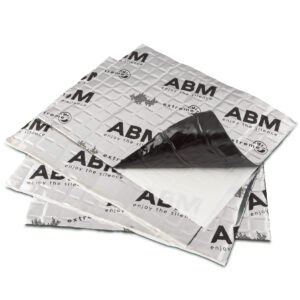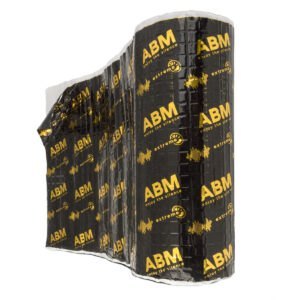Modern automotive engineering places high demands on driving comfort. Effective protection against noise and corrosion is a priority. Butyl mats offer an advanced solution that addresses both issues simultaneously.
Protection against corrosion remains crucial for vehicle owners in Poland. Moisture, road salt, and harsh weather conditions damage metal body parts. Traditional protection methods often fail or require frequent renewals.
Butyl is characterized by exceptional sealing properties. Using this material in car mats opens new possibilities for vehicle protection. Significant savings in maintenance costs are an additional benefit.
Anti-corrosion properties of butyl mats in protecting metal components
Butyl mats demonstrate remarkable protective abilities against corrosion. Applying mats to metal surfaces creates an effective barrier against moisture and oxygen. The molecular structure of butyl features exceptionally low gas permeability.
Corrosion begins when metal comes into contact with moisture and oxygen. Butyl mats interrupt this process at the very start. The hermetic protective layer blocks corrosive agents from reaching metal surfaces.
Technical studies confirm the material’s effectiveness. Butyl exhibits gas permeability levels of 1.1-1.5 g/cm³. This value is among the lowest for elastomeric materials.
Waterproof properties of butyl as a moisture barrier
The waterproof nature of butyl mats results from their unique chemical structure. Butyl molecules form a dense network that blocks water penetration. The material maintains waterproof properties across a wide temperature range.
The operating range includes temperatures from minus 40 to plus 120 degrees Celsius. Hydrophobic properties remain stable over years of use. The material does not degrade under prolonged water exposure.
The butyl structure resists moisture absorption. This property prevents the formation of corrosion spots beneath the mat. Material stability guarantees long-lasting protection.
Flexible material structure preventing cracking and infiltration
The flexibility of butyl mats is a key factor in their anti-corrosion effectiveness. The material retains flexibility across a broad temperature range. Microcracks do not form even with intensive use.
The elongation coefficient of butyl reaches 600%. This property allows adaptation to various surface shapes. The material’s structure conforms to irregular forms without losing tightness.
Butyl is characterized by fatigue resistance. Regular vibrations and deformations do not damage the mat. The continuity of the protective layer remains intact during intensive vehicle use.
The aging process of butyl proceeds very slowly. The material shows exceptional resistance to ozone and UV radiation. Mechanical properties remain stable throughout its service life.
Long-term protection of car bodywork against rust
Applying butyl mats to critical body parts provides protection exceeding 10 years. The material creates a barrier isolating metal from aggressive external factors. Manufacturers offer warranties on butyl products up to 5 years.
The effectiveness of corrosion protection depends on proper application. The metal surface requires thorough cleaning and degreasing before adhesion. Properly applied butyl forms a continuous protective layer blocking corrosion.
Key benefits of protection:
- Elimination of spot corrosion at weld points
- Protection of component edges from moisture penetration
- Securing recesses prone to salt accumulation
- Isolation of contact points between different metals
Butyl mats demonstrate particular effectiveness in protecting areas exposed to road salt. Edges of components, welds, and recesses receive effective protection against spot corrosion.
Tip: Before applying butyl mats, remove all traces of corrosion using chemical or mechanical methods to ensure maximum protection effectiveness.
Applications of butyl mats in automotive soundproofing
The automotive sector increasingly uses butyl mats as a primary soundproofing material. Butyl’s acoustic properties surpass traditional bituminous materials. The material density is 1.3-1.4 g/cm³, providing effective vibration damping.
Installing butyl mats in vehicles brings significant acoustic benefits. Noise level reduction reaches 38 dB. This value exceeds most solutions available on the market.
The versatility of butyl mat applications allows comprehensive vehicle soundproofing. The material adheres to various surfaces without the need for heating. The self-adhesive layer ensures a durable bond with the metal substrate.
Installation on door panels to reduce external noise
The vehicle doors are the main route for external noise penetration into the cabin. Applying butyl mats to the inner surfaces of panels significantly improves acoustic comfort. The material effectively dampens noise from street traffic and weather conditions.
The optimal amount of material for a pair of front doors is about 0.5 m² (converted from 2 m² PLN). Rear doors require about 0.375 m² (converted from 1.5 m² PLN) of material. Precise installation requires shaping the mat to fit the panel geometry.
The material is applied to flat surfaces, avoiding areas with technical holes. Proper placement ensures maximum soundproofing effectiveness. Even surface coverage eliminates acoustic bridges.
Soundproofing the trunk floor and passenger cabin
The vehicle floor transmits a significant amount of vibrations and noise from the drivetrain. Tire contact with the road surface generates additional noise. Butyl mats applied to the floor create an effective acoustic barrier.
A material thickness of 1.3-4 mm provides adequate vibration damping. Comprehensive trunk soundproofing requires about 0.75 m² (converted from 3 m² PLN) of butyl mats. Wheel areas require special attention due to intense vibrations.
Zones requiring floor soundproofing:
- Driveshaft tunnel and gearbox area
- Wheel wells and fenders
- Flat surfaces of the trunk floor
- Sills and structural elements
The application covers horizontal and vertical surfaces of wheel wells. The material adapts to complex structural shapes. Thorough coverage eliminates vibration propagation points.
Elimination of Vibrations from the Engine and Drive System
The internal combustion engine generates intense vibrations transmitted to the vehicle structure. Butyl mats applied in the engine compartment effectively dampen vibrations. Temperature resistance up to 170 degrees Celsius allows for safe use.
The drive system includes the transmission, driveshaft, and axles. Components generate vibrations at various frequencies. Butyl mats adapt to the frequency spectrum, providing broadband damping.
The material maintains effectiveness across the entire engine speed range. The flexible structure adapts to changing operating conditions. Property stability guarantees long-lasting efficiency.
Thermal Insulation Reducing Air Conditioning Load
The insulating properties of butyl mats go beyond acoustic aspects. The material serves as an effective thermal barrier limiting heat flow. A 0.1 mm thick aluminum layer enhances heat reflection properties.
Effective thermal insulation translates into reduced air conditioning load. Maintaining a constant temperature requires less energy. Benefits include faster cabin heating during winter.
Stable interior temperature affects passenger comfort. Smaller temperature fluctuations improve travel conditions. Thermal insulation supports the operation of HVAC systems in the vehicle.
Tip: Combining butyl mats with rubber foam provides optimal thermal and acoustic insulation properties with minimal increase in vehicle weight.
Financial Savings from Using Butyl Mats
Investing in butyl mats brings measurable economic benefits in the long term. The cost of a complete set of mats for a typical car is 162-300 EUR. The expense pays off through reduced repair and maintenance costs.
Operating cost analysis highlights the importance of anti-corrosion protection. Vehicles with professional protection retain higher market value. The value difference can reach several thousand euros upon sale.
Comprehensive protection eliminates the need for regular anti-corrosion treatments. Traditional methods require renewal every 2-3 years. Additional costs and vehicle downtime burden the owner’s budget.
Reducing Corrosion Repair Costs in Long-Term Use
Corrosion repair costs increase exponentially with vehicle age. Replacing body parts can cost several or even tens of thousands of euros. Professional painting of a single part ranges from 125-375 EUR.
Butyl mats prevent corrosion formation in the most vulnerable areas. Sills, door edges, and wheel wells receive effective protection. Eliminating corrosion helps avoid costly structural repairs.
Estimated corrosion repair costs:
- Sill repair – 500-1,250 EUR
- Door section replacement – 200-500 EUR
- Wheel well repair – 375-750 EUR
- Paint restoration – 75-200 EUR per part
Corrosion prevention is a far cheaper solution than repairing damage. Investment in butyl mats pays off multiple times over. Eliminating structural repairs extends vehicle lifespan.
Increasing Vehicle Market Value Through Professional Soundproofing
Professional vehicle soundproofing positively impacts market value. Buyers appreciate acoustic comfort and pay a higher price. The difference can reach 5-10% of the vehicle’s value upon sale.
Comprehensive soundproofing demonstrates the owner’s care for the vehicle. Potential buyers perceive such vehicles as better maintained. Investing in butyl mats translates into higher attractiveness on the secondary market.
Vehicles with professional soundproofing sell faster. Acoustic comfort is a significant decision factor for buyers. Shortening the sales time brings additional economic benefits.
Fuel Consumption Reduction Through Better Thermal Insulation
Effective thermal insulation of butyl mats leads to reduced fuel consumption. Maintaining a comfortable temperature requires less air conditioning work. Savings can reach 3-5% of fuel consumption.
Thermal insulation speeds up the heating process inside the vehicle. Shorter operation at elevated idle speeds means lower fuel consumption in winter. Annual savings can amount to several hundred euros.
Stable interior temperature reduces the load on HVAC systems. Lower energy consumption translates into longer component lifespan. Benefits include increased comfort in vehicle use.
Tip: Combining acoustic and thermal insulation of butyl mats with additional insulating materials can increase fuel savings up to 8% in extreme temperature conditions.
Diverse Applications of Butyl Mats Beyond Automotive
The applications of butyl mats extend far beyond the automotive sector. Industry utilizes the acoustic and anti-corrosion properties of the material in various applications. Construction, maritime industry, and industrial sectors are dynamically developing areas.
The versatility of butyl mats stems from the material’s exceptional properties. Resistance to weather conditions, chemicals, and extreme temperatures allows use in demanding environments. The material maintains effectiveness for many years without maintenance.
Growing demands for acoustic comfort across sectors drive demand for effective materials. Butyl mats meet the needs of industry and construction. Professional solutions ensure long-lasting efficiency.
Soundproofing Industrial Equipment and Production Machines
The manufacturing industry generates intense noise requiring effective soundproofing. Butyl mats applied to machine enclosures significantly reduce noise emission. The material effectively dampens vibrations from gearboxes, electric motors, and pneumatic systems.
The use of butyl mats benefits employees and the environment. Noise level reduction improves working conditions and lowers the risk of hearing damage. Occupational health and safety regulations increasingly require effective workplace soundproofing.
Typical industrial applications:
- Compressors and refrigeration units
- Textile and printing machines
- Ventilation and air conditioning devices
- Electric generators and transformers
The effectiveness of soundproofing depends on the proper application of the material. Covering critical surfaces eliminates the main sources of noise. Professional installation ensures maximum system efficiency.
Acoustic insulation of pipelines and ventilation ducts in construction
Ventilation systems in buildings are a source of noise transmitted through the structure. Butyl mats applied to ducts effectively dampen the noise of flowing air. The material insulates vibrations transmitted through fasteners and supports.
Water and sewage pipelines generate noise during media flow. Wrapping pipes with butyl mats eliminates sound propagation through the building structure. This solution is used in residential and hotel construction.
Heating installations require acoustic insulation due to the noise from circulation pumps. Butyl mats provide effective soundproofing while maintaining thermal insulation properties. The combination of acoustic and thermal benefits increases system efficiency.
Use in the marine industry for silencing boats and yachts
The marine environment places special demands on insulation materials. Butyl mats show exceptional resistance to moisture, sea salts, and UV radiation. The material retains its properties over years of operation in an aggressive environment.
Ship engines generate intense vibrations and noise transmitted through the hull. Applying butyl mats to engine room bulkheads effectively insulates cabins from engine noise. The material dampens vibrations originating from auxiliary systems.
Acoustic comfort on floating units affects rest quality and crew safety. Noise reduction improves sleeping conditions and communication among crew members. Professional soundproofing is a standard in modern marine construction.
Tip: In the marine environment, it is especially important to ensure airtight connections of butyl mats to prevent moisture and salt penetration under the insulation layer.
Butyl mats at ABM Insulation store
ABM Insulation store specializes in providing modern soundproofing solutions for various applications. The company focuses on top-quality butyl materials that effectively reduce noise and vibrations. The offer includes two main lines of butyl products designed for demanding customers.
Many years of experience in the insulation materials industry allows the company to deliver solutions that meet the highest standards. Products available in the store have passed rigorous quality tests. A five-year warranty confirms the reliability of the offered materials.
Professional Series for Universal Applications
Professional series butyl mats are the core product line in the store’s offer. The materials feature thicknesses ranging from 1.3 to 4 mm with various sheet and roll formats. A 0.1 mm thick aluminum layer provides effective thermal insulation.
The Professional series products operate at temperatures from minus 40 to plus 170 degrees Celsius. The flexible material structure allows easy adaptation to different surfaces. The self-adhesive system eliminates the need for additional heating during installation.
Main features of Professional mats:
- Effective noise and vibration reduction in vehicles
- Durable adhesive layer without the need for heating
- Resistance to cracking at extreme temperatures
- Safe composition free of toxic compounds
- Protection against moisture and mold
Applications include soundproofing passenger cars, delivery vans, and trucks. The materials also perform well in industrial machinery and construction installations. Flexibility allows installation in hard-to-reach areas.
Butyl Soundproofing Mats ABM Professional in the ABM Insulation store
Xtreme Series for the Highest Demands
The Xtreme line represents the premium class of soundproofing materials in the store’s offer. The products feature enhanced noise reduction effectiveness while maintaining ease of installation. The advanced butyl formula ensures maximum durability under extreme conditions.
Xtreme butyl mats stand out with an exceptionally strong adhesive layer and increased material flexibility. The products contain no asphalt, eliminating the risk of cracking at low temperatures. Resistance to liquids and mold allows use in humid environments.
Advantages of Xtreme series mats:
- The highest soundproofing effectiveness offered
- Increased flexibility for complex shapes
- Exceptional resistance to extreme conditions
- Long-term stability of insulating properties
- Trouble-free installation without specialized tools
Premium-class materials are used in luxury vehicles and demanding industrial installations. The Xtreme series is also suitable for marine industry applications, such as soundproofing boats and yachts.
Butyl Soundproofing Mats ABM Xtreme in the ABM Insulation store
ABM Xtreme Premium Self-adhesive Butyl Soundproofing Mat in rolls, 2.5mm, 2m2
Acoustic Butyl Mat Self-adhesive ABM Xtreme Premium in rolls, 2.0mm, 2m2
Professional Consulting and Technical Support
ABM Insulation provides comprehensive technical support for customers selecting butyl materials. Experienced specialists advise on choosing appropriate products for specific applications. Assistance also includes installation instructions and optimization of material quantities.
The company delivers products throughout Poland and European Union countries. Fast order fulfillment and flexible delivery terms facilitate planning soundproofing projects. Professional customer service guarantees purchase satisfaction.
Contact us for professional advice on selecting butyl mats tailored to your needs. Order high-quality soundproofing materials and experience the effectiveness of solutions offered by ABM Insulation.
Technical characteristics and construction of butyl mats
The structure of butyl mats features a well-designed multilayer construction. The base consists of a butyl layer with a thickness of 1.2-3.5 mm. The material provides damping and sealing properties with a density of 1.3-1.4 g/cm³.
The mechanical properties of butyl include tensile strength of 4-6 MPa. The relative elongation reaches up to 400%. These parameters ensure the durability of the material under intense deformation and temperature changes.
Hardness according to the Shore A scale is 50-60 degrees. This value provides optimal material flexibility. The operating temperature ranges from minus 40 to plus 170 degrees Celsius.
Three-layer construction with a butyl layer and aluminum foil
The construction of butyl mats consists of three main functional layers. The outer layer is aluminum foil with a thickness of 0.1 mm. This layer provides heat reflection and protection against radiation.
The aluminum layer increases the stiffness of the entire structure. It facilitates the application of the material on various surfaces. Thermal reflection improves the insulation properties of the entire system.
The middle layer is butyl, responsible for damping and anti-corrosion properties. The thickness of this layer determines acoustic effectiveness and adaptability. Butyl is characterized by excellent adhesion to various materials.
| Layer | Thickness | Function |
|---|---|---|
| Aluminum foil | 0.1 mm | Heat reflection, rigidity |
| Butyl | 1.2-3.5 mm | Damping, sealing |
| Self-adhesive glue | 0.05-0.1 mm | Adhesion to substrate |
The bottom layer consists of a self-adhesive glue protected by a protective foil. The adhesive layer ensures a durable bond with the substrate. The system eliminates the need for additional fastening measures.
Operating temperature parameters from minus 40 to plus 170 degrees Celsius
The operating temperature range of butyl mats exceeds the requirements of most applications. The lower limit of minus 40 degrees ensures functionality in the harshest winter conditions. The material remains flexible at extremely low temperatures.
The upper limit of plus 170 degrees allows for use near heat sources. Internal combustion engines or exhaust systems are not a problem. Butyl does not undergo thermal decomposition nor emit harmful substances.
Adhesive properties remain stable throughout the entire temperature range. The self-adhesive layer does not lose adhesion at low temperatures. High temperatures do not cause the glue to melt.
Comparison of effectiveness with traditional bituminous materials
Butyl mats outperform traditional bituminous materials in terms of effectiveness and durability. Bitumen tends to harden at low temperatures. High temperatures cause the material to soften.
Butyl maintains stable properties over a wide temperature range. Its resistance to aging far exceeds that of bituminous materials. Bitumen degrades under ozone and UV radiation.
The adhesive properties of butyl mats remain stable throughout their service life. Bituminous materials often lose adhesion after several years of use. Investing in butyl mats ensures long-term effectiveness.
| Parameter | Butyl Mats | Bituminous Materials |
|---|---|---|
| Temperature Range | -40°C to +170°C | -20°C to +60°C |
| Durability | >10 years | 3-5 years |
| Flexibility | Constant | Variable with temperature |
Tip: When selecting soundproofing material, consider the vehicle’s operating conditions and the expected durability of the solution to achieve an optimal cost-benefit ratio.
Practical Installation Instructions for Butyl Mats
The proper installation of butyl mats determines the effectiveness of the entire insulation system. The application process requires thorough surface preparation and adherence to technological procedures. Properly executed installation ensures full functionality of the material.
The ambient temperature during installation should be 15-25 degrees Celsius. These conditions provide optimal adhesion of the adhesive layer and facilitate shaping the material to the surface contours.
Air humidity should not exceed 70%. Required tools include a cutting knife, a pressure roller, and degreasing agents. Preparing the appropriate set speeds up the process and improves workmanship quality.
Surface Preparation and Cleaning Before Application
Cleaning the surface is a key element of the installation process. The metal surface must be completely free of rust, paint, and dirt. Residual contaminants prevent proper adhesion of the material.
The cleaning process begins with mechanically removing loose contaminants. Sandpaper with a grit size of 120-240 removes rust and old paint coatings. Hard-to-reach areas require wire brushes or mechanical tools.
Surface preparation procedure:
- Mechanical removal of rust and paint
- Degreasing with solvent or gasoline
- Drying the surface with compressed air
- Cleanliness inspection before application
Thorough surface preparation ensures maximum material adhesion. Skipping any step may lead to premature loss of adhesion. Quality control of cleaning eliminates problems during operation.
Application Techniques Without Heating the Material
The self-adhesive system of butyl mats eliminates the need for heating before application. Removing the protective film exposes a highly adhesive layer. The material adheres to the surface under mechanical pressure.
Application is done gradually, avoiding air bubbles. The material is pressed with a roller or by hand from one edge. Even pressure ensures full adhesion across the entire contact surface.
Shaping the material to complex forms utilizes butyl’s flexibility. The material conforms to recesses and edges without cracking. Areas with high curvature require special attention during pressing.
Avoiding Installation Errors for Maximum Effectiveness
The most common installation errors include insufficient surface cleaning and leaving air bubbles. Incorrect cutting of the material also reduces insulation effectiveness. Each mistake shortens the material’s lifespan.
Leaving air bubbles under the mat creates stress concentration points that can cause material detachment during use. Thorough pressing of the entire surface eliminates air and ensures full adhesion.
Cutting the material requires a sharp knife and a stable surface. A dull blade leads to frayed edges and weakened structure. Precise measurement before cutting minimizes material waste.
Key installation rules:
- Thorough cleaning and degreasing of the surface
- Gradual application with even pressure
- Elimination of air bubbles during application
- Use of sharp tools for cutting the material
After installation, the vehicle should be left at room temperature for at least 24 hours to allow the adhesive layer to reach full bond strength.
Summary
Butyl mats are an advanced technical solution effectively combining anti-corrosion protection with vehicle soundproofing. The material’s properties include waterproofing, flexibility, and temperature resistance, ensuring long-term protection of metal components. Investing in professional butyl mats brings measurable economic benefits by reducing repair costs and increasing the vehicle’s market value.
The applications of butyl mats extend beyond the automotive sector, covering industry, construction, and the marine sector. The versatility of the material and its exceptional technical properties open broad possibilities for use in diverse operating environments. Proper installation and adherence to technological procedures ensure maximum effectiveness of the insulation system.
The development of butyl mat technology and growing demands for acoustic comfort and anti-corrosion protection indicate a steady increase in the material’s importance. Professional solutions based on butyl mats represent the future of comprehensive protection and insulation for vehicles and industrial facilities.
Sources:
- https://en.wikipedia.org/wiki/Butyl_rubber
- https://www.sciencedirect.com/science/article/pii/S1359836819341095
- https://advanced.onlinelibrary.wiley.com/doi/10.1002/admt.202401669
- https://pmc.ncbi.nlm.nih.gov/articles/PMC12158252/
- https://pmc.ncbi.nlm.nih.gov/articles/PMC9105723/
- https://www.j-cst.org/main/abstract_view.htm?scode=C&code=C00210100001&vol=21&no=1&type=aissue
- https://cameo.mfa.org/wiki/Butyl_rubber
- https://www.ranal.pl/media/download/689df6034c14005698c6e15368eab8f3.pdf
- https://abmtrade.eu/butyl-soundproofing-mats-abm-professional/
- https://butylcompound.com/en/the-use-of-butyl-in-anti-corrosion-applications/


